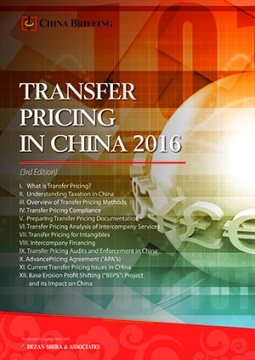China Promulgates Transfer Pricing Measures
Jan. 13 – The State Administration of Taxation promulgated the much-anticipated transfer pricing measures detailing the administrative rules for all special tax adjustments on Friday. These special tax adjustments, including cost sharing, thin capitalization, anti-avoidance, and transfer pricing documentation requirements, where first outlined in chapter 6 of China’s Corporate Income Tax Law.
The new measures, which take effect retroactively from January 1, 2008, are divided into seven chapters: general provision, reporting related party transactions, the administration of contemporaneous documentation, transfer pricing methods, transfer pricing investigations and adjustments, the administration of advanced pricing arrangements, and the administration of cost sharing agreements.
The measures are intended to ensure high standards and consistency throughout the various local tax bureaus in China, making the administration and enforcement of transfer pricing-related issues uniform. The new rules will act as a foundation for future policy changes to China’s transfer pricing regime.
Related party transactions
Nine different forms may now need to be filed, they include:
- Related party relationships
- Summary of related party transactions
- Purchases and sales
- Labor services
- Intangible assets
- Fixed assets
- Financing
- Foreign investment status
- Foreign payments
The implantation measures state that in addition to resident enterprises in China, foreign companies with an establishment or place of business in China who file corporate income tax returns in China must also file these required documents.
Transfer pricing documentation
Enterprises with business in China must have relevant transfer pricing documentation or face an additional interest levy of 5 percent on any transfer pricing adjustments. There are 26 specific items of documentation needed which break down into five basic categories:
- Organizational structure
- Description of business operations
- Description of related party transactions
- Comparability analysis
- Selection and application of transfer pricing method
Companies that fail to submit this documentation could see the Chinese tax authorities determine what their taxable income is and asses a 5 percent penalty in addition to normal People’s Bank of China lending rate as part of an interest levy in addition to any fines.
There are some exemptions from this requirement for certain enterprises, and small taxpayers with limited related party dealings could qualify for this.
Transfer pricing methods
The implantation measures list six “appropriate methods for transfer pricing:
- Comparable uncontrolled price method
- Resale price method
- Cost plus method
- Transactional net margin method
- Profit split method
- Other methods consistent with the arm’s length principle
When choosing a method, companies will need to take into account the characteristics of the assets or services involved in the transaction, the functions and risks of each transactional party, the terms of the contract, the economic circumstances, and their business strategies.
Enforcement
The authorities will investigate on companies that tend to have the following characteristics: significant amounts or numerous types of related party transactions; long-term losses low profitability, or fluctuating patters of profit and loss; below average profitability than industry standards or profits that do not match the companies functions; business dealings with companies established in tax havens; absent of incomplete transfer pricing documentation; obvious violations of the arm’s length principle.
According to the implementation measures, no transfer pricing adjustment will be made to related party transactions between domestic related parties that had the same effective tax burden.
Other points of interest
The new implantation measures also provide administrative guidance on debt-to-equity ratios pertaining to the thin capitalization rules, further clarifies how the Chinese tax authorities will undertake anti-avoidance investigations, legal liabilities for failure to submit transfer pricing documentation, and a supplementary provision extending to December 31, 2009 the date of completion of transfer pricing documentation for 2008 (related party transaction disclosure forms for 20008 will still need to be filed by May 31, 2009).
![]()
 Transfer Pricing in China 2016
Transfer Pricing in China 2016
Transfer Pricing in China 2016, written by Sowmya Varadharajan in collaboration with Dezan Shira & Associates and Asia Briefing, explains how transfer pricing functions in China. It examines the various transfer pricing methods that are available to foreign companies operating in the country, highlights key compliance issues, and details transfer pricing problems that arise from intercompany services, intercompany royalties and intercompany financing.
 Annual Audit and Compliance in China 2016
Annual Audit and Compliance in China 2016
In this issue of China Briefing, we provide a comprehensive analysis of the various annual compliance procedures that foreign invested enterprises in China will have to follow, including wholly-foreign owned enterprises, joint ventures, foreign-invested commercial enterprises, and representative offices. We include a step-by-step guide to these procedures, list out the annual compliance timeline, detail the latest changes to China’s standards, and finally explain why China’s audit should be started as early as possible.
Managing Your Accounting and Bookkeeping in China
In this issue of China Briefing, we discuss the difference between the International Financial Reporting Standards, and the accounting standards mandated by China’s Ministry of Finance. We also pay special attention to the role of foreign currency in accounting, both in remitting funds, and conversion. In an interview with Jenny Liao, Dezan Shira & Associates’ Senior Manager of Corporate Accounting Services in Shanghai, we outline some of the pros and cons of outsourcing one’s accounting function.
- Previous Article Dezan Shira’s Tax Network World’s Third Largest
- Next Article China’s Money Supply Posts Fastest Increase










